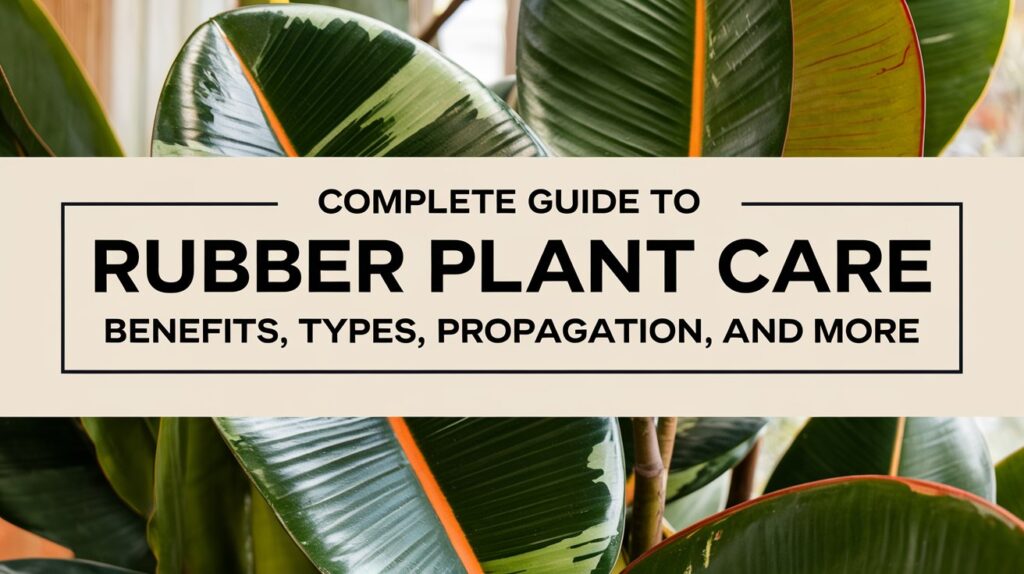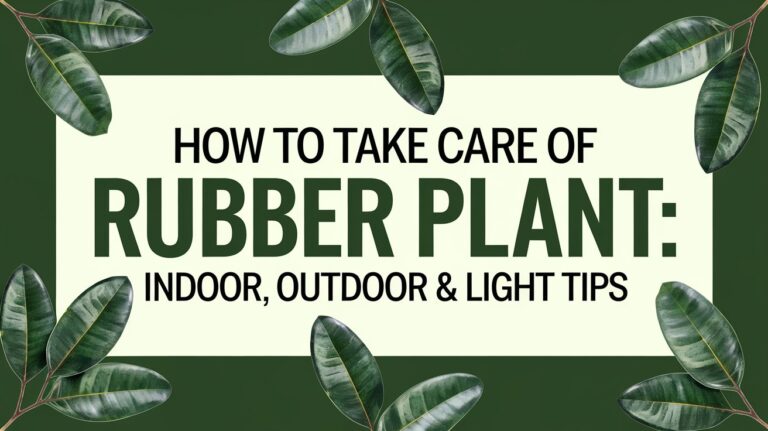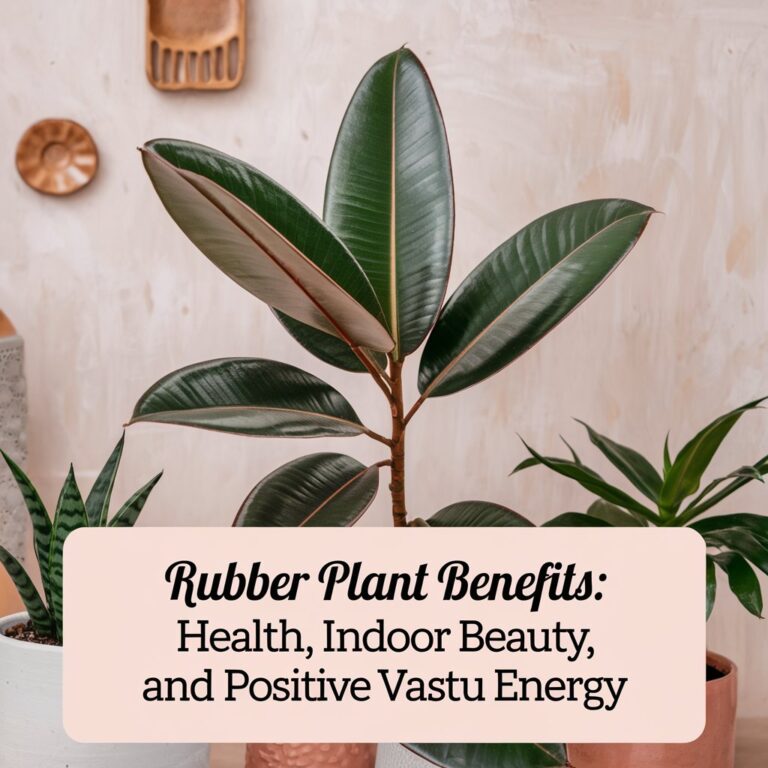If you want to bring a touch of greenery and elegance into your home, the Rubber Plant (Ficus Elastica) could be a perfect choice. Known for its deep green leaves and easygoing nature, it’s a wonderful indoor plant that’s not just low-maintenance but also quite beneficial for indoor air quality.
In this guide, I’ll take you through everything I’ve learned about Rubber Plant care – from its watering needs to propagation and even a few tips from Vastu Shastra for positive placement in your home.
Rubber Plant Care Essentials
Rubber Plant Soil Requirements
The right soil mix makes all the difference when it comes to caring for a Rubber Plant. Ideally, they thrive in well-draining soil that’s rich in nutrients. I find that a mix of regular potting soil with added perlite or peat moss works wonders. The perlite helps with drainage, which is essential to prevent the roots from sitting in water and developing rot. When choosing the best potting soil for Rubber Plants, consider a mix that maintains moisture without staying too wet. This setup allows the roots to get the water they need without risking waterlogged conditions.
Does Rubber Plant Need Sunlight?
Yes, Rubber Plants do need sunlight, but they prefer indirect or filtered light. Placing them near a window with bright, indirect light works well. I have mine in a corner that gets morning sunlight, which helps it thrive without burning its leaves. While they can tolerate lower light, a little sunlight brings out their best color and growth. If you’re growing your Rubber Plant indoors and struggling with low light, a grow light can also help.
Rubber Plant Watering Guide
One key aspect of Rubber Plant care is proper watering. I find that Rubber Plants are fairly forgiving, but it’s crucial to avoid overwatering. During warmer months, I water mine once a week, but in winter, I let the soil dry out more between waterings. Pay close attention to how fast the soil dries; watering needs can vary based on your home’s humidity. Overwatering often causes leaf drop, so it’s better to err on the side of caution.
Optimal Temperature and Humidity for Rubber Plants
Rubber Plants enjoy warm and humid environments, similar to their tropical origin. A temperature range between 60-80°F (15-27°C) is ideal. If you’re dealing with dry indoor air, especially in winter, consider misting the leaves occasionally or using a pebble tray. I’ve found that a humidifier works wonders for my indoor plants, keeping them hydrated and vibrant.
Rubber Plant Propagation Methods
Propagating Rubber Plants from Cuttings
One of the easiest ways to expand your Rubber Plant collection is through stem cuttings. Simply cut a healthy stem with a few leaves attached, dip it in the rooting hormone, and place it in water or directly into the soil. The roots take a few weeks to form, and during this period, maintaining stable humidity and indirect light helps the cutting establish itself. If you’re looking for a step-by-step guide, check out my detailed post on Areca Palm Propagation, which covers similar propagation techniques.
Air Layering Propagation
Air layering is another great option for a more advanced propagation technique. This method encourages roots to form while the stem is still attached to the parent plant. I wrap a moist sphagnum moss around a cut on the stem and cover it with plastic wrap. This method has a higher success rate for Rubber Plants, especially for larger plants that may struggle with rooting in soil alone.
Different Types of Rubber Plants for Your Indoor Space

Ficus elastica ‘Robusta’
Known for its large, glossy dark green leaves, ‘Robusta’ is the classic Rubber Plant variety. Its lush, vibrant foliage adds a timeless, tropical feel to any space and is also one of the easiest types to care for, making it ideal for beginners.
Ficus elastica ‘Burgundy’
This variety features striking deep burgundy leaves, almost black under low light. ‘Burgundy’ Rubber Plants bring a dramatic look to interiors and are perfect for anyone seeking a bold yet low-maintenance houseplant.
Ficus elastica ‘Tineke’
‘Tineke’ stands out with its variegated leaves in shades of green, cream, and pink. This variety requires slightly more light to maintain its unique coloring but rewards with beautiful pastel tones that brighten up indoor spaces.
Ficus elastica ‘Ruby’
With striking pink, red, and cream variegation, the ‘Ruby’ Rubber Plant is a favorite for its vibrant colors. Like ‘Tineke,’ it thrives best in bright, indirect light to maintain its beautiful colors.
Ficus elastica ‘Decora’
Featuring wider and slightly larger leaves than ‘Robusta,’ the ‘Decora’ variety has deep green leaves with a hint of bronze. It’s a robust plant that adds an exotic touch to any room and is very adaptable to indoor environments.
Ficus elastica ‘Melany’
‘Melany’ has smaller, more compact leaves with a darker green hue, making it a great choice for smaller spaces or as a tabletop plant. It has a bushier growth pattern, which adds density and depth to its look.
Rubber Plant Benefits: Air Purification and More
Health Benefits of Rubber Plants
Rubber Plants are more than just pretty additions to your space – they’re also natural air purifiers. Studies have shown that they can help filter toxins like formaldehyde from the air, which is fantastic if you’re looking to improve your indoor air quality. If you’re curious about more plant-related air-purifying benefits, I recommend my blog on Areca Palm Benefits for a broader look at how plants boost indoor air quality.
Aesthetic and Emotional Benefits
On top of air purification, Rubber Plants bring a calming, tropical vibe to any room. Their large leaves create a sense of relaxation, which is perfect for creating a stress-free home environment. In my experience, Rubber Plants are a beautiful statement piece that ties the room together effortlessly.
Rubber Plant Vastu: Placement Tips and Benefits
Best Placement for Rubber Plant as per Vastu
According to Vastu Shastra, the Rubber Plant is considered auspicious for indoor spaces, as it symbolizes wealth and positivity. Ideally, it’s best placed in the east or southeast direction of your home. I find that positioning it in the living room or near the entrance attracts positive energy while enhancing the space’s aesthetic appeal.
Vastu Benefits of Keeping a Rubber Plant Indoors
The Rubber Plant is said to bring prosperity and good fortune, making it an excellent choice for home decoration and positive energy. I’ve noticed that it not only brings a lush, green element indoors but also gives a sense of tranquility and balance to my home.
Common Rubber Plant Leaf Issues and Solutions
Why Rubber Plant Leaves Turn Yellow
Yellowing leaves can be an early sign of improper care. Overwatering or inadequate sunlight are common culprits. If you see yellow leaves, consider adjusting your watering schedule and ensuring your plant receives the right amount of light.
Drooping, Falling, or Brown Leaves on Rubber Plants
Rubber Plant leaf issues like drooping or browning may result from factors such as inconsistent watering or sudden temperature changes. In my experience, ensuring stable humidity and a consistent watering schedule greatly helps in keeping leaves healthy. For more leaf care tips, you might find my blog on Areca Palm Leaf Troubles useful, as similar practices apply to Rubber Plants.
How to Clean and Maintain Rubber Plant Leaves
Rubber Plants have large leaves that tend to gather dust, which can reduce their ability to absorb light. Gently wiping the leaves with a damp cloth every few weeks keeps them looking fresh and vibrant. Clean leaves also reduce pest issues, ensuring your plant stays healthy and grows steadily.
Conclusion
The Rubber Plant is a wonderful, low-maintenance houseplant that adds not only beauty but also health benefits to your home. With the right care, including ideal soil, proper light, and a thoughtful watering schedule, this plant will thrive and bring a lush green touch to your indoor space. By following the tips in this guide, you’re well on your way to enjoying a vibrant and healthy Rubber Plant.
Hi, I’m Pritesh, the heart and hands behind Roots & Earth. My love for plants started when I was just 5 years old, planting trees alongside my grandfather. Those early experiences in the garden left a lasting impression, shaping my deep connection to nature and sparking a lifelong passion for nurturing green spaces.
With an MBA under my belt, I’ve blended my business acumen with my love for gardening, creating Roots & Earth as a way to share my knowledge and inspire others. When I’m not working in my own home garden, you’ll find me traveling to the mountains—my favorite getaway for reconnecting with the natural world.
At Roots & Earth, I’m here to guide you on your gardening journey, whether you’re a seasoned green thumb or just starting out. Together, let’s cultivate beautiful, thriving spaces that enrich our lives and the earth.




